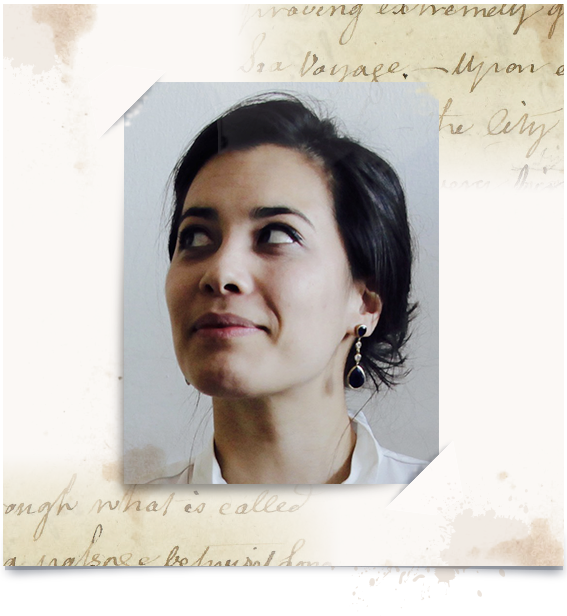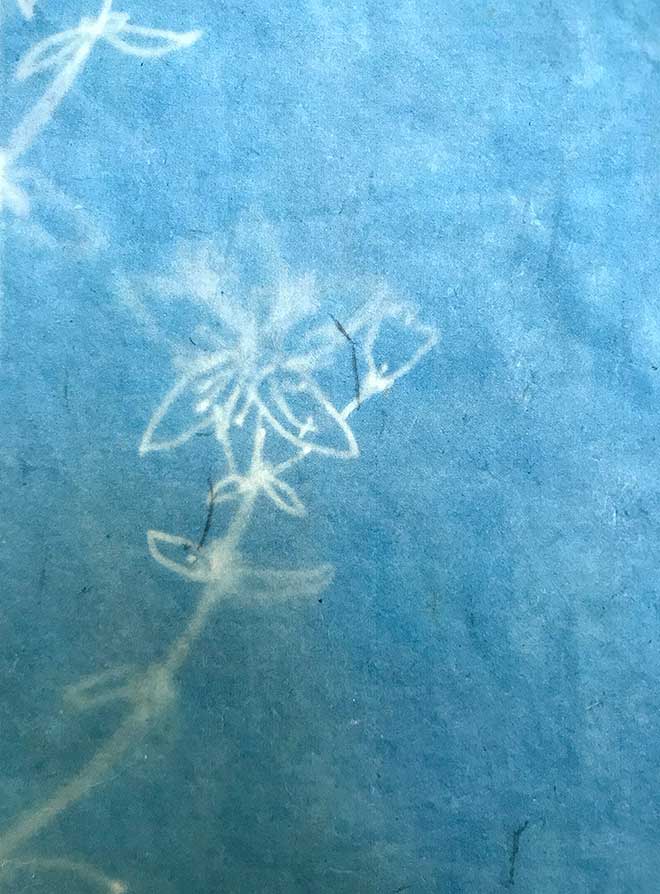Under different skies
An essay and poetry by Heather H Yeung


Heather H Yeung is a literary critic, theorist, poet, and artist book maker. She currently teaches in the School of Humanities at the University of Dundee, and was previously assistant professor at Bilkent University, Ankara. Her work has been exhibited and performed internationally. An archive, recently partly digitised, of poetry objects and artist books, is held in the Scottish Poetry Library. Her academic publications include 'Spatial Engagement with Poetry' (2015) and 'On Literary Plasticity' (2020).
From the strange frame which is the window of the aeroplane the evidence — visual — appears to prove that the machine, with its hundreds of people inside, has broken into a different layer of sky. The river, the sea, the land, its buildings, the electric glow of motorways and mosques, disappear under the clouds which form shapes, and in which — in the inevitable search for visual order — we see land, sea, buildings, animals ('look, Anne!' a child points, or, since they are unseen must presumably be pointing, to the window in a row behind, 'that one's like our cat!') but which possess, of course, a fluid mode of interaction of their own quite untouched by our way of looking, even though the contrails of our present passage may momentarily force some form of atmospheric disruption.
As ever in this and in so many comparable moments, as my mind turns from the clouds the same avowal clouds my mind. I promise next time I will look better, will open my ears to listen more attentively, turn with a greater flexibility towards all that — all this — which I again move away from and which is always that which is not my own even as each time I move towards it with open eyes, arms, mind. But again, this time, I have been for too long reliant on my status as guest. Next time, yes, next time I will hear more, see differently, will attend to all that which I am sure I have so far missed, will ask the questions I only now feel are formulating, will wait for the answers which I know now can come forth toward me as strongly in silences as they may in words. Yes, next time …
Next time I will perhaps be able to begin to apologise for every trip that this time, that next time, is not and will not be. But what, after all that can this promise be except that it is a promise of departure?
The Listons, as we know, travelled to Ottoman Turkey on a diplomatic posting travelling eastwards across the Mediterranean in 1812, leaving again in 1820.
In reading the work I was brought quite quickly to ask myself why it was that throughout her husband's posting to Turkey Henrietta Liston, it seems, rarely looks up at the sky or towards the horizon line and marvels. I cannot pretend to provide any sort of answer. Particularly since material rather than epistolary evidence would suggest that this is not a woman for whom looking was inimical. She, as botanical specimens brought on and brought back from both this and her American tour attest, was brought, often, to look with precision and care, and at times with an interesting sort of counterintuition.
Over and again the writing demonstrates a particular point of view, well-educated and measured but very different from the mode of aristocratic and / or hyperaestheticised orientalisms which dominate Anglophone travelling perspectives in the early 19th century, and withal, in moments, wry with a particular humour based on an almost stereotypically non-aristocratic self-consciousness about the poses that she affords, and the potential throughout her visit for all sorts of cross-cultural misinterpretation. Drawing further attention to this doggedness, Liston even writes acerbically (and perhaps knowingly? in her life as a diplomat's wife she had experienced up to this point re-organisations of structures of rule in America and France, a proliferating bourgeoisie) about that infamous previous Turkish traveller Lady Mary Wortley Montagu's rather different style and perspective. Liston's detailed diary, full of observations quotidian and extraordinary, literary and mundane, takes care absolutely to retain its measure; it possesses a scope and tone which is expressly not florid, and which is explicitly conscientious in its attempts to be as precise as regards material detail as possible. The birth, perhaps, of middle-class travel writing?
For all this (a conscientious reading of my own), I was still puzzled by Henrietta Liston's lack of sky.
An open confession, now. Discounting the imaginative projection via the view (standing or swimming) from Greek islands to Turkish coast, and Turkish islands to the Greek coast, I have travelled into and out of Modern Turkey by sky, only, even as the way by boat, by train, by car, bicycle, foot, horse, exists and is more practicable for many in any of these other modes. So it may be that my own perspectives on Turkey, either through direct observation or remembrance mediated through Liston's diary, are framed by a perspective that regardless of other ana- or para-chronisms is something which was impossible for Liston to share.
The sky, or travel by it, would have been a barely thinkable option for this traveller — Henrietta Liston — even as she lived in and through a hey-day in scientific, literary, political, and philosophical thought, doing so on both sides of the Atlantic, often, if momentarily, in the presence of the key figures. Balloons, before the Listons arrived in Turkey, had travelled, albeit with some hap and little idea of passage, in Europe and America. The directly observed aerial perspective was nascent, but not yet ubiquitous; the sky was, however, a matter for serious aesthetic as well as meteorological consideration.
The puzzle linked to this confession might be the usual trick of anachrony or projection which occurs when reading travel- or other writing of direct observation and reflection, however recently written it may be, and however familiar the subject matter may be that it seeks to articulate. The divide between reader and writer is ever there, and is a gap of desiring, for sure (for who, in reading such writing is not possessed by some sort of wish 'to be there', or even 'to be there, then'). Recast that, perhaps: 'to have been there'. Or, 'would that one could have been there then, one also might also have seen, heard, touched, smelled, understood …' Or, 'I wonder, then, what it is that is really shared in this act of looking not quite alongside what is quite another perspective?'; 'how can this not be simply some form of transumption? ought it to be? might it not?'. For in this puzzle, from the start of this writing, from the promise, the looking 'with' another perspective, the tinted lens of the subjunctive haunts supreme.

Sunprint: Hypericum (detail).
After the Claude glass and its filtered perspectives, at the height of the meteorological vogue in 1810, William Oram's 'Precepts and Observations on the Art of Colouring in Landscape Painting' was posthumously compiled and published by Charles Clarke. Close to its beginning the principles of light and the sky, of direct observation of and practical artistic interaction with meteorological phenomena, take precedence: 'In every composition, care is to be particularly taken that some object be placed under the principal light that is in nature of a light colour in itself, and so of all other lights.'
Look, then, to the dominant tones of light, and, as we reach Chapter V, to the skies, and the clouds: '… in preparing a ground for these colours for finishing the clouds, first scumble a colour respectively under every cloud upon the aether colours, much bluer and much lighter than the shades of the clouds which are to come upon it, though very little darker than the aether, and it is to be every where very thinly laid on : let this be made up with blue, white, and a little lake, which, when judiciously scumbled according to the design, is broken upon into all the shapes of the clouds, with the colours above described in their respective gradations of distance, leaving this tint to appear in the proper places, according to the various dispositions of the clouds.'
And the attentiveness to sky bridges the Liston's Turkish period: in a letter of 1821 Constable wrote, 'It will be difficult to name a class of landscape in which the sky is not the key-note, the standard of scale, and the chief organ of sentiment.' To capture, to 'frame', a landscape, it seems we are in need of a certain sort of aerial sensitivity. There is no question that, even with more than two clear centuries of disjunction, we can agree that the sky is a perceptual phenomenon that we share, onto which we are, and have ever been, prone to projection of all sorts.
Now place this alongside the following:
Off the Sicilian cost, Henrietta Liston observes '[t]he softness of the climate, the calmness of the sea, and the serenity of the sky were charming, while the slowness of our movements gave us the opportunity of viewing, at leisure, the beautifully indented hills and varieties of coast'.
And from the Cycladic archipelago '[n]othing can equal the charms of this climate, the beauty of the sky, without heat to oppress, and quite sufficient for comfort and for pleasure. […] The glassy surface of the water, the unclouded sky and the rosy tinges of the setting sun, were worthy [of?] the pencil of Claude Lorrain'.
The Mediterranean approach to Turkey is, it seems, already framed, aestheticized to a sort of descriptive numbness for Henrietta Liston. Here we have her polite observations of people, of landscapes, of the peripheries of political interactions framed by these rather dull general observations of the maritime and coastal scene. The sky is an inevitability, and to be remarked upon thus, and no more. These short, relatively uninteresting sentences are the only mentions of the sky in Henrietta Liston's diary, even as the Listons' frequent travel by both road and water demanded near-constant elemental attunement, and even as for almost half a year in 1814 Henrietta maintained a meteorological journal. Is it significant (it cannot really be a philhellenism on the part of Henrietta) that expansive aerial-focussed expression is limited to appreciations of Greece (the cloud-shrouded Turkish Mount Olympos allows for some vertical perspective, but brief, and journeying, only), and even these are framed by more practical, less aesthetically burdened, contextual observations? What do Liston's skies — or their lack — tell us? Or, where are they?

Sunprint: Thymus (detail).
To return to the puzzle: if the request is to write (or to perceive) in interaction with a perspective from a thinkable but ultimately unknowable perception of a place with which one, too, has familiarised oneself over a period of years, but where the first perspective is a couple of centuries adrift from one's own, how can due acknowledgement be made of the absolute divide, whilst at the same time acknowledging, too, the strange resonances? Reading moments in Liston's writing I am forced to look up, to pause from reading, to turn to face the sky in order to think through the possible bridge, the divide.
Travel writing, travel journals or diaries, even the epistolary recces — letters 'open', 'closed', circulated widely, cribbed, and copied, of the traveller — traditionally effect this act of acknowledgement by acts of deft (and sometimes not so deft) silting: accepting or rejecting previous perspectives on a given 'scene', following 'in the footsteps of', comparing to the descriptions of, and subsequently reacting to, and often against, the other frame.
Here, now, I write from Scotland not Turkey, and so am reliant on diaries and sketchbooks from my own life there placed alongside the typescript of Liston's diaries, received here, which deal with a different, but similar, elsewhere. I must refuse my 'academic' hat (the 'period' of the diaries is far from 'my own'; the practical tone of Liston's diaries seem to demand a similar recourse to a non-literary-critical vision). The disjunct, the resonances, begin, through these material forms, to become clearer to me as does the way and means of reaction. The sun streams into the broad windows of my study; the haar shrouds the hills across the river, and will soon burn off.
It may be of course that much of Henrietta Liston's Turkish stay was spent with the sky blocked: passing under lintels, in covered passages between building to building. This is not inconceivable and also perhaps explains how the Greek days, in which there are greater skies, may be marked by a greater sense of view (from a boat or temporary point of stay), as the traveller's roving eye is in motion — has a different sense of the space in which they move. And yet, in Turkey, she also travelled. And there, she also gardened.
Without the sky, Henrietta Liston's landscapes are pigmented by repeated observations of foliate coloration. Her interest at times is to look down to the plant life, which we may guess she did much more than she articulates in the diary. Unless it is a matter of making a morphological distinction (as with, for instance, her writing about the rock rose) the colours of the plants are implied by the mention of their names and the dating of the diary, giving a season, through which we may infer colouration of foliage, flower, bark … We are expected, then, to be able to pigment our reading landscape by the implications of the play of species, of pigment and light. But in looking down with such intensity, what then happens when you look up again?

Sunprint: Cistus (detail).
What is it one remembers of a scene, of a stay, of the words in this diary?
If you look hard enough at a given object in strong light, when you close your eyes its impression will be printed, obliquely, and still 'visible', including more often than not surrounding lines hitherto unobserved although extant within the field of vision.
Coups d'oeil become ghostly impressions, contrails, briefest of sunprints on the eye, a trick of the remembering mind.
It's perhaps inevitable that I should have equated with, even imposed upon each other, the impressions of Henrietta Liston's diary and my own. 'I promise next time I will look better, will open my ears to listen more attentively, turn with greater flexibility towards all that — all this — which I again move away from and which is always that which is not my own.' The work emerging from this interaction became a sort of double-exposure, whereby moments of silence in Liston's writing became noisy with moments from the same places two centuries adrift.
Such superimposition (and what an imposition) became something less feasible through the linear mode of this prose-essay, and more possible, perhaps, in both printing and poetry. How is it, indeed, that we feel that we can see (or hear) simultaneously; how is it when we know that what we read, the medium through which we are attempting this feat, has also undergone processes of redrafting, rewriting through memory's lens … ?
There is now an artist's book of poems and prints, 'Anadolu', that seeks in some way to place alongside a sense of dogged materiality (my Turkish gains from Liston's observations and collections) with a sense of the sky. For it may be that the sky — in its changeability, in our quick tricks through which in observational writing we so often ignore it or seek to make it possess a heavy object- or narrative- life — is ultimately the only and most impossible thing that we should share.